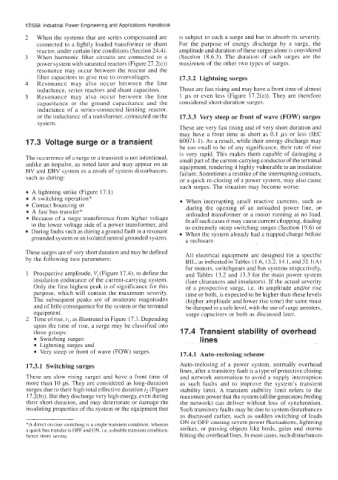Page 593 - Industrial Power Engineering and Applications Handbook
P. 593
171.558 Industrial Power Engineering and Applications Handbook
2 When the systems that are series compensated are is subject to such a surge and has to absorb its severity.
connected to a lightly loaded transformer or shunt For the purpose of energy discharge by a surge, the
reactor, under certain line conditions (Section 24.4). amplitude and duration of these surges alone is considered
3 When harmonic filter circuits are connected to a (Section 18.6.3). The duration of such surges are the
power system with saturated reactors (Figure 27.2(c)) maximum of the other two types of surges.
resonance may occur between the reactor and the
filter capacitors to give rise to overvoltages. 17.3.2 Lightning surges
4 Resonance may also occur between the line
inductance, series reactors and shunt capacitors. These are fast rising and may have a front time of almost
5 Resonance may also occur between the line 1 ps or even less (Figure 17.2(a)). They are therefore
capacitance or the ground capacitance and the considered short-duration surges.
inductance of a series-connected limiting reactor,
or the inductance of a transformer, connected on the 17.3.3 Very steep or front of wave (FOW) surges
system.
These are very fast rising and of very short duration and
may have a front time as short as 0.1 ,us or less (IEC
17.3 Voltage surge or a transient 6007 I - I). As a result, while their energy discharge may
be too small to be of any significance, their rate of rise
is very rapid. This makes them capable of damaging a
The occiirrence of a surge or a transient is not intentional, small part of the current-carrying conductor of the terminal
unlike an impulse, as noted later and may appear on an equipment, rendering it highly vulnerable to an insulation
HV and EHV system as a result of system disturbances, failure. Sometimes a restrike of the interrupting contacts,
such as during: or a quick re-closing of a power system, may also cause
such surges. The situation may become worse:
A lightning strike (Figure 17.1)
A switching operation* When interrupting small reactive currents, such as
Contact bouncing or during the opening of an unloaded power line, an
A fast bus transfer" unloaded transformer or a motor running at no load.
Because of a surge transference from higher voltage In all such cases it may cause current chopping, leading
to the lower voltage side of a power transformer, and to extremely steep switching surges (Section 19.6) or
During faults such as during a ground fault in a resonant When the system already had a trapped charge before
grounded system or an isolated neutral grounded system. a reclosure.
These surges are of very short duration and may be defined All electrical equipment are designed for a specific
by the following two parameters: BIL,asindicatedinTables 11.6, 13.2, 14.1,and32.1(A)
for motors, switchgears and bus systems respectively,
1 Prospective amplitude, V, (Figure 17.4), to define the and Tables 13.2 and 13.3 for the main power system
insulation endurance of the current-carrying system. (line clearances and insulators). If the actual severity
Only the first highest peak is of significance for this of a prospective surge, Le. its amplitude and/or rise
purpose, which will contain the maximum severity. time or both, is expected to be higher than these levels
The subsequent peaks are of moderate magnitudes (higher amplitude and lower rise time) the same must
and of little consequence for the system or the terminal be damped to a safe level, with the use of surge arresters,
equipment. surge capacitors or both as discussed later.
2 Time of rise, t,, as illustrated in Figure 17.3. Depending
upon the time of rise, a surge may be classified into
three groups: 17.4 Transient stability of overhead
Switching surges lines
Lightning surges and
Very steep or front of wave (FOW) surges. 17.4.1 Auto-reclosing scheme
17.3.1 Switching surges Auto-reclosing of a power system, normally overhead
lines, after a transitory fault is a type of protective closing
These are slow rising surges and have a front time of and network automation to avoid a supply interruption
more than 10 ps. They are considered as long-duration as such faults and to improve the system's transient
surges due to their high total effective duration t2 (Figure stability limit. A transient stability limit refers to the
17.2(b)). But they discharge very high energy, even during maximum power that the system (all the generators feeding
their short duration, and may deteriorate or damage the the network) can deliver without loss of synchronism.
insulating properties of the system or the equipment that Such transitory faults may be due to system disturbances
as discussed earlier, such as sudden switching of loads
ON or OFF causing severe power fluctuations, lightning
*A direct on-line switching is a single transient condition, whereas
a quick bus transfer is OFF and ON, is. adouble transient condition, strikes, or passing objects like birds, gales and storms
hence more severe. hitting the overhead lines. In most cases, such disturbances

